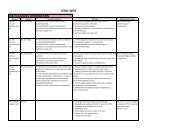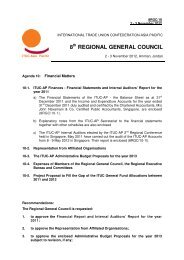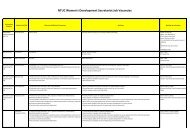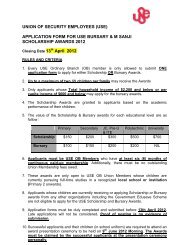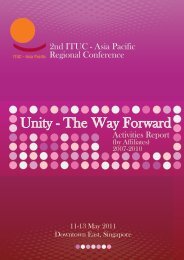BANGLADESH LABOUR LAW: - People Tree Foundation
BANGLADESH LABOUR LAW: - People Tree Foundation
BANGLADESH LABOUR LAW: - People Tree Foundation
Create successful ePaper yourself
Turn your PDF publications into a flip-book with our unique Google optimized e-Paper software.
Child labour: still a reality. Both the garments and construction industries still employ<br />
child workers (below 14 years of age), per observation by 9.9 per cent of worker<br />
respondents in the garments industry and 13.1 per cent in construction. Three<br />
respondents happen to be below 14. The employment of child workers in both the<br />
garments and construction industries is governed by oral contract. The nature of work<br />
given to these child workers are the same as those given to adult workers.<br />
Women discriminated in job placement, increment and promotion. Female garments<br />
workers are not discriminated with regard to wages. But they face discrimination in job<br />
placement, increment and promotion. In the construction industry, females are<br />
discriminated in wages, benefits and other areas.<br />
High occupational risks, low risk information, limited risk prevention. Workers in both<br />
industries face numerous occupational risks and accidents. The most common risks in<br />
garments are the “pricking of finger by needle” followed by “cuts” in hand. In<br />
construction, the most common risk is “falling down from high place.” And yet,<br />
employers usually do not provide information on these occupational risks, as explained<br />
by 43 per cent of worker respondents in the garments industry and 65 per cent in<br />
construction. Majority (61.8 % in garments and 72.1 % in construction) of respondents<br />
said that authorities have not taken any measure to prevent further accidents at their<br />
workplaces. In garments, while some measures are taken, these are not sufficient and<br />
often done before the global buyers’ presence.<br />
Safety facilities: inadequate in garments and absent in construction. In garments<br />
factories, fire extinguishers and emergency stairs are present but are generally inadequate<br />
compared to the number of workers. Some factories do not even have these facilities,<br />
with emergency stairs even kept under lock and key by some employers. Safety<br />
equipments and tools are also not always provided to the workers. A large number (46%)<br />
of respondent do not know whether they are provided safety tools. Many workers also do<br />
not get any risk reduction training. Only 2.8 per cent of the construction workers get<br />
safety tools from the employer.<br />
Unfriendly work place environment. While majority of the respondents said that the<br />
conditions of ventilation, lighting, temperature and humidity are good in their work place,<br />
about one-fourth said that this is not so. In the construction sector, most of the<br />
respondents claimed that the facilities to contain dirt, heat, ventilation, dust, noise,<br />
smoke, humidity and so on are bad or non-existent. Further, in most cases, there is no<br />
safe drinking water.<br />
<br />
Occupational illness, The proportions of workers who said that they have suffered<br />
occupational illness are 18.4 per cent in garments and 29 per cent in construction.<br />
Harassments at the workplace. About 40 per cent of the garments workers and 30 per<br />
cent of the construction workers said that they endure mental harassment (due to verbal<br />
abuse and the likes). More worrisome, more than one-fifth (21.7 %) in the garments<br />
12








